Iceland Tectonic Plates Diving Tours – Imagine drifting weightlessly between two massive slabs of Earth’s crust, immersed in water so clear it feels like floating through glass. This isn’t a dream—it’s diving between the tectonic plates in Iceland, one of the most surreal and awe-inspiring underwater experiences on the planet.
In the heart of Þingvellir National Park, where the North American and Eurasian tectonic plates slowly drift apart, lies a geological wonder called Silfra. This glacial spring-fed fissure is the only place on Earth where you can scuba dive or snorkel directly between two continents.
What is Iceland Tectonic Plates Diving?
Iceland Tectonic Plates Diving takes place in Silfra Fissure, a narrow, water-filled crack between the North American and Eurasian tectonic plates. Located in Þingvellir National Park, a UNESCO World Heritage Site, Silfra is one of the most geologically significant dive locations in the world.
As the two plates drift apart, Silfra continues to widen slowly each year. This site offers divers a rare chance to touch two continents at once, while floating through glacial meltwater filtered naturally through volcanic rock. The result is a surreal underwater world with rock walls, sand bottoms, and endless visibility.
Understanding the Iceland Tectonic Plates Diving
Iceland is situated directly on the Mid-Atlantic Ridge, where the North American and Eurasian tectonic plates meet. As these plates gradually drift apart—by about 2 centimeters per year—they create rifts and valleys across the island. Þingvellir (Thingvellir) National Park is one of the most dramatic examples of this tectonic activity on land.
Deep cracks and fissures have formed in the Earth’s surface, and Silfra Fissure is one of the few filled with crystal-clear glacial meltwater, creating a diving site like no other.
Related: Scuba Diving on a Komodo
What Makes This Dive Site Unique?
Silfra is often called “the clearest water in the world”, and with good reason—visibility can exceed 100 meters. That clarity, combined with the ability to physically touch two tectonic plates, makes this dive a geological and visual marvel.
The water, sourced from Iceland’s Langjökull glacier, takes decades to filter through porous volcanic rock before entering the fissure, making it ultra-pure, cold, and stable year-round. The underwater landscape features sheer lava walls, narrow passages, and breathtaking formations sculpted by thousands of years of seismic movement.
Silfra Fissure: The Main Dive Site
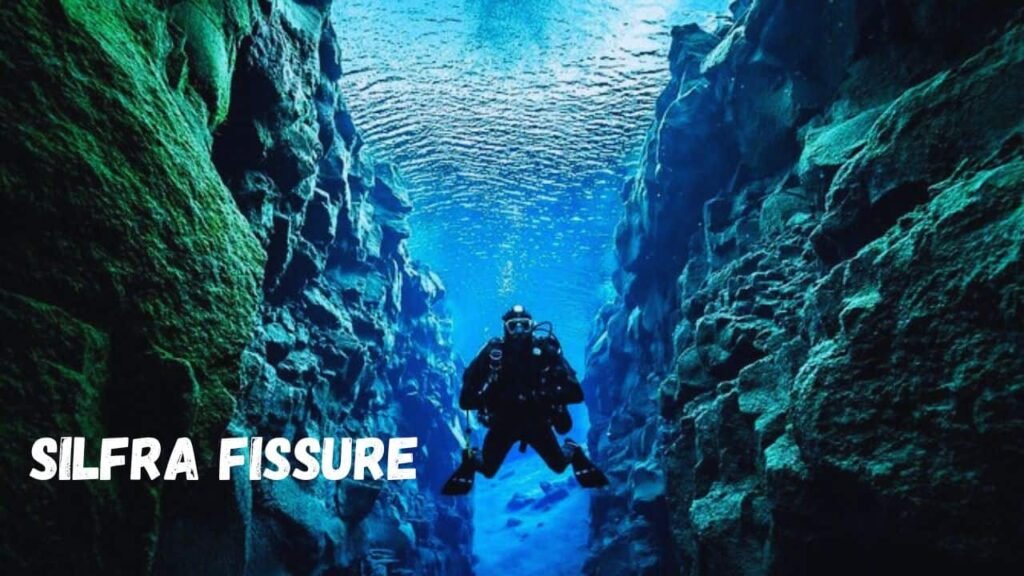
Located within Þingvellir National Park—a UNESCO World Heritage Site—Silfra Fissure is the top destination for diving between tectonic plates. It consists of four main sections:
- The Big Crack – The narrowest part where divers can touch both plates at once.
- Silfra Hall – A wide section with towering lava walls.
- Silfra Cathedral – The deepest and most awe-inspiring area with light-filled underwater canyons.
- Silfra Lagoon – A peaceful, shallow area ideal for taking in the expansive visibility.
Despite the cold temperatures (typically 2–4°C), divers are protected by dry suits, allowing for an extended, comfortable experience underwater.
READ: Molokini Is The Best Snorkeling Spot In Hawaii
Who Can Dive at Silfra?
Silfra diving is reserved for those with experience. To scuba dive, you must:
- Hold at least a PADI Open Water certification (or equivalent).
- Have dry suit certification or proof of recent dry suit diving experience.
- Be at least 18 years old, in good health, and able to handle cold-water conditions.
For non-divers, snorkeling is a fantastic alternative. It requires no diving certification and is accessible to confident swimmers aged 12 and up.
What to Expect During the Iceland Tectonic Plates Diving?
A typical dive at Silfra begins with a gear fitting and safety briefing by your certified guide. You’ll be suited up in a thermal base layer, a neoprene hood and gloves, and a fully sealed dry suit. After a short walk to the entry point, you’ll enter the fissure and begin your 30- to 40-minute dive.
Underwater, expect stunning visibility, narrow passages, and light streaming through ancient lava formations. The cold water can be bracing at first, but once you adjust, the sensation is otherworldly. Buoyancy control is crucial in the dry suit, and guides are always nearby to assist.
Read More: How to Visit the Galapagos Islands
How Do I Book a Dive or Snorkel Tour at Silfra?
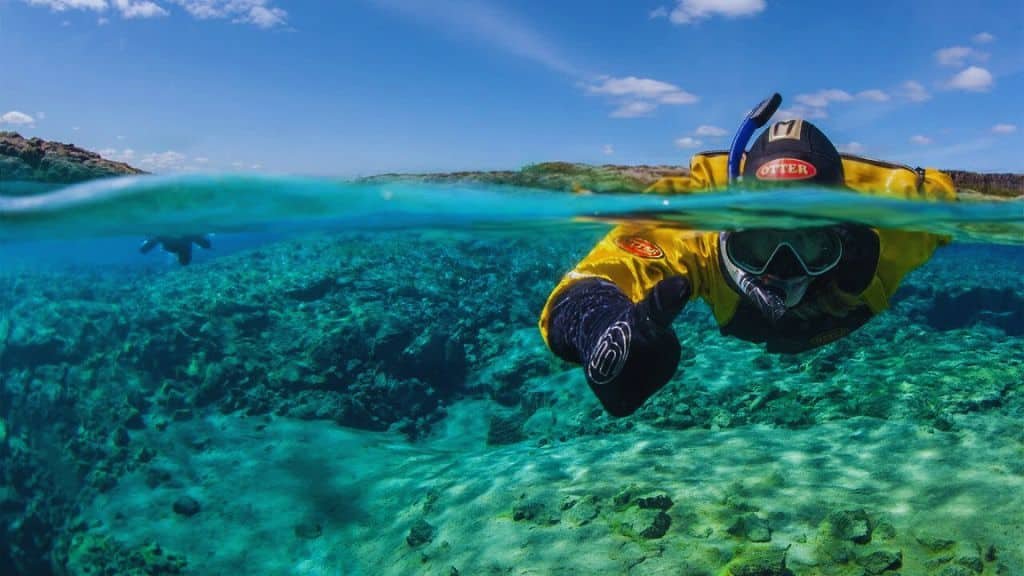
Booking a Silfra dive or snorkel tour is straightforward through one of Iceland’s licensed tour operators, such as Dive.is Arctic Adventures, or Adventure Vikings. Tours include all necessary equipment: dry suits, masks, snorkels, gloves, fins, and for divers, tanks and weights. Most operators also cover Þingvellir National Park entrance fees and provide free underwater photos.
Some offer hotel pickup from Reykjavik, while others require meeting at the dive site. It’s recommended to book at least 2–3 weeks in advance, especially during peak summer months or holiday seasons. Review all health, swim, and certification requirements before reserving your spot.
Tour Operators and Booking Tips
Several reputable tour companies offer diving and snorkeling trips to Silfra. Notable operators include Dive.is Arctic Adventures and Adventure Vikings. Packages usually include:
- All gear (dry suits, tanks, weights, masks, fins)
- Certified dive or snorkel guides
- Park entrance and permit fees
- Free underwater photos
- Optional transportation from Reykjavik
Booking Tips:
- Reserve early, especially during summer months.
- Verify your certifications and experience.
- Dress warmly and bring extra clothes and a towel.
Read Also: Scuba Diving In Malta
Do I Need to be a Certified Diver to Dive in Silfra?
Yes, scuba diving at Silfra requires at least an Open Water Diver certification (PADI, SSI, or equivalent) along with either a dry suit diving certification or proof of recent dry suit experience. This is because of the cold-water conditions and specialized gear involved. Dive tours typically verify your qualifications during booking.
However, for non-certified individuals, snorkeling is an equally rewarding option. It offers a similar view of Silfra’s crystal-clear fissure from the surface, and only requires that you be a confident swimmer, typically age 12 and up, and in good health.
How Cold is The Water at Silfra?
The water in Silfra is consistently 2 to 4 degrees Celsius (35–39°F) all year round. Despite Iceland’s varying seasons, this temperature remains steady because the water comes from the Langjökull glacier, Iceland’s second-largest ice cap. Before reaching Silfra, the meltwater takes 30–100 years to travel underground through layers of lava rock, becoming both filtered and chilled.
While the water is frigid, participants wear insulated dry suits, thermal undergarments, and protective hoods and gloves, which help retain body heat and keep them dry. Though your face and hands may feel cold at first, most people find the experience manageable and even refreshing.
Is It Safe to Dive or Snorkel Between the Tectonic Plates?
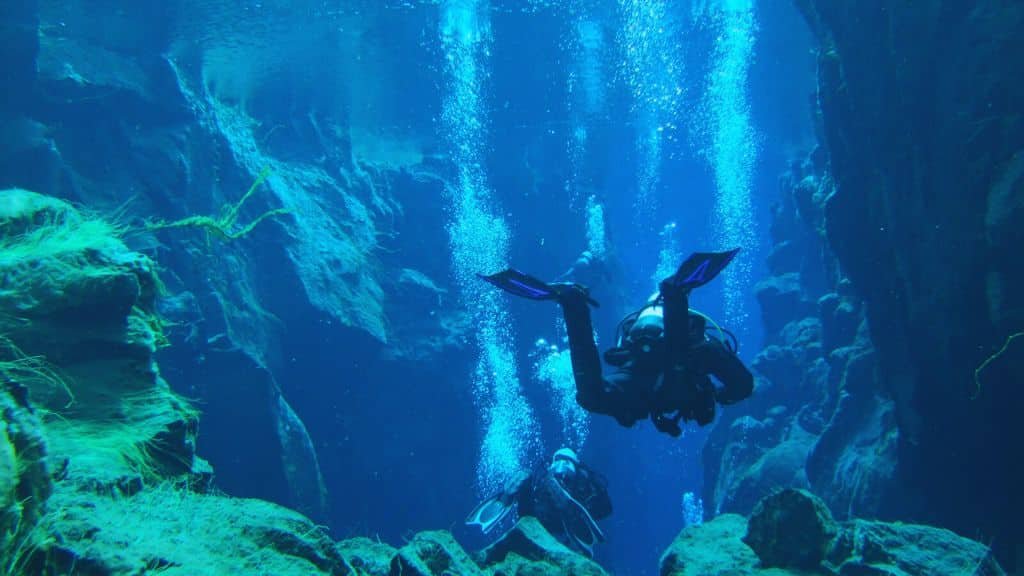
Yes, diving and snorkeling at Silfra are highly regulated and safe, especially when done through certified tour operators. Professional guides accompany every group, providing a comprehensive safety briefing, assisting with gear fitting, and monitoring the dive from entry to exit. The fissure’s calm, slow-moving water and high visibility reduce risk, even for first-time snorkelers.
Silfra has an excellent safety record thanks to its controlled environment, clear rules, and well-maintained equipment. Tour operators also provide dry suits, safety vests, and flotation aids to ensure participants remain buoyant and comfortable throughout the experience.
Read Also: Silfra Fissure
What Does the Dive Look Like Underwater?
Underwater, Silfra is unlike any other dive site. The fissure’s walls are formed from ancient lava rock, creating narrow passageways, deep trenches, and shimmering caverns. Silfra is divided into distinct sections:
- The Big Crack – The narrowest part where you can reach out and touch both tectonic plates.
- Silfra Hall – A wide corridor lined with towering lava rock walls.
- Silfra Cathedral – A vast chamber known for its remarkable depth and light effects.
- Silfra Lagoon – A shallow, serene area perfect for ending the dive with panoramic views.
The water’s exceptional clarity—often over 100 meters—reveals even the finest details, such as colorful algae clinging to rocks. Unlike most dive sites, Silfra has no fish or coral reefs, so the focus is entirely on the geological and visual experience.
Can I Do This Experience in Winter?
Yes, Silfra is open year-round, and many divers prefer winter visits for the quiet atmosphere, reduced crowds, and magical snowy landscapes. The underwater experience remains nearly identical in every season, as the water temperature remains stable. In winter, you’ll suit up in warm base layers before donning the dry suit.
Tour operators take extra precautions to ensure comfort in colder air temperatures, offering heated vans, hot drinks, and shorter prep times. Winter dives are especially popular with photographers and nature lovers, as the contrast between icy landscapes and blue water is visually stunning.
To Know More: Nusa Penida Diving Courses
Environmental and Safety Considerations
Silfra lies within a protected national park, and strict guidelines are in place to preserve the site’s delicate environment. All visitors must:
- Use eco-friendly products (no sunscreen or lotions allowed in water).
- Follow Leave No Trace principles.
- Respect the rules set by the rangers of Þingvellir National Park and tour operators.
Safety is a top priority. Guides are highly trained, equipment is well-maintained, and briefings cover all aspects of the dive to ensure a secure and enjoyable experience.
Conclusion
Diving or snorkeling between the tectonic plates in Iceland is more than just a thrill—it’s a rare opportunity to witness Earth’s power and beauty up close. Silfra Fissure offers an unforgettable combination of geological significance, surreal underwater scenery, and pristine conditions that few places in the world can match. Whether you’re an experienced diver or a curious snorkeler, this is one adventure that truly lets you float between worlds.


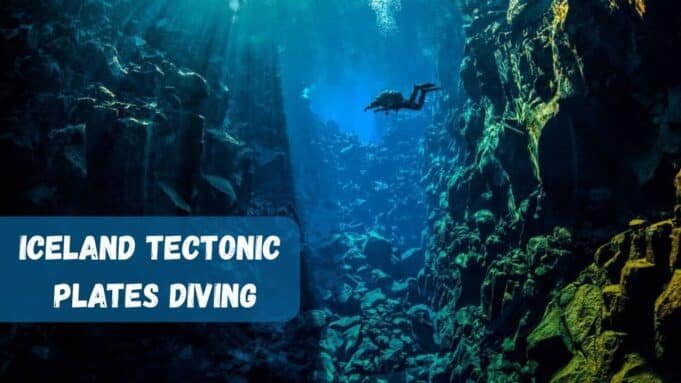

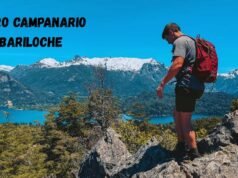











[…] Read Also: Iceland Tectonic Plates Diving Tours […]
[…] wine tastings: Taste premium wines on private tours of renowned […]
Comments are closed.